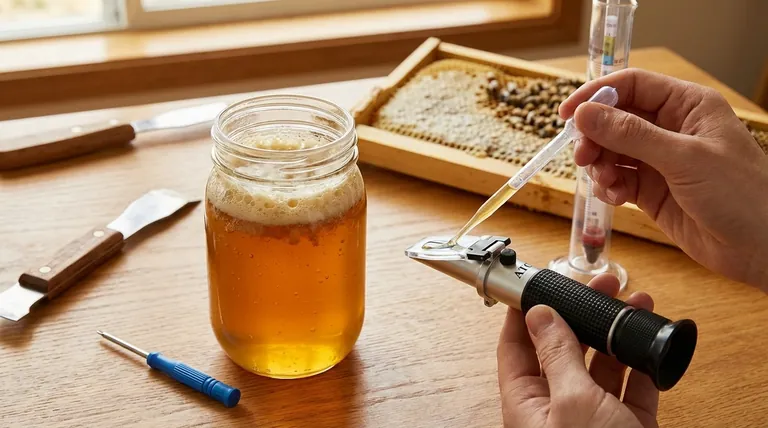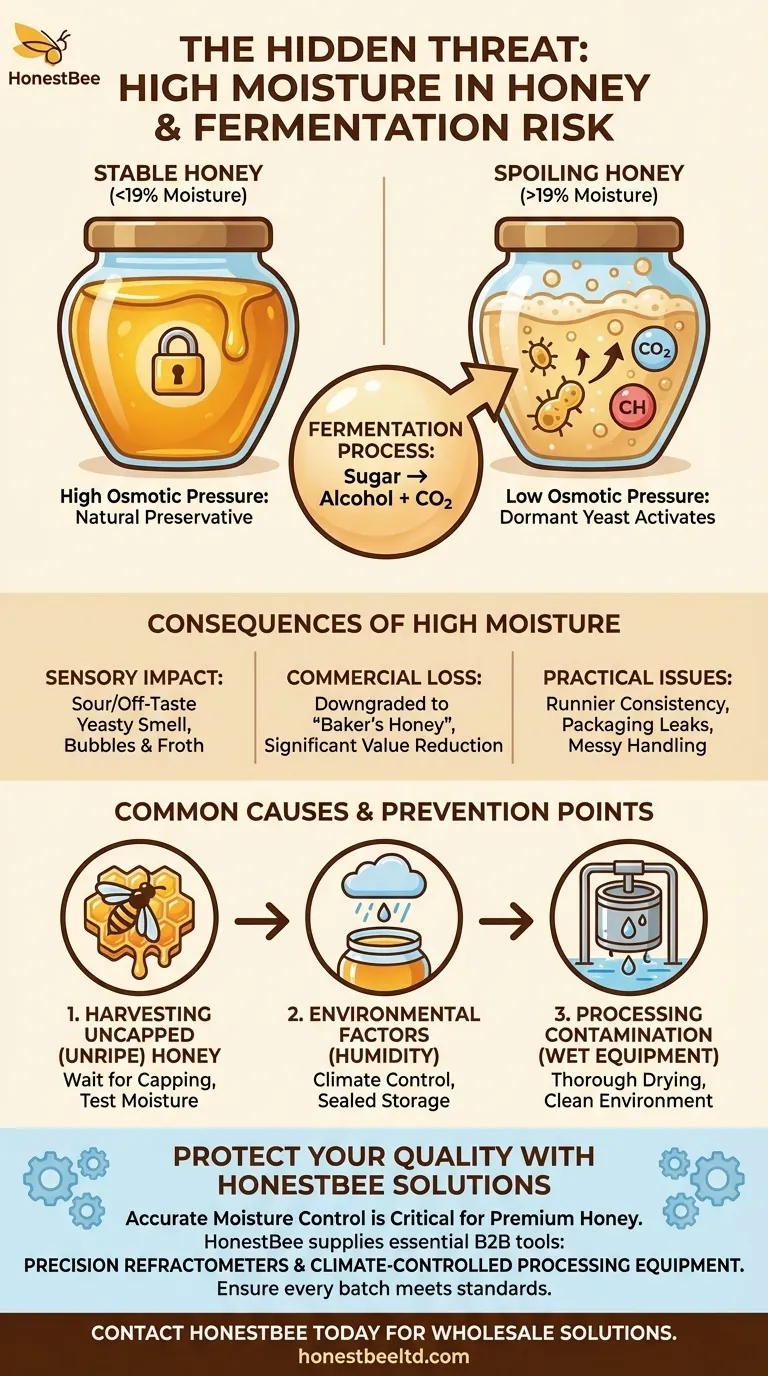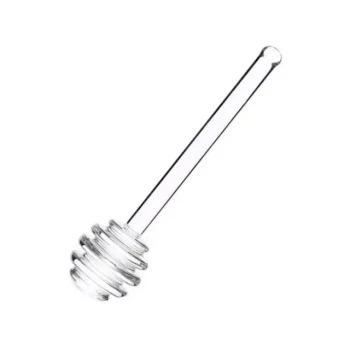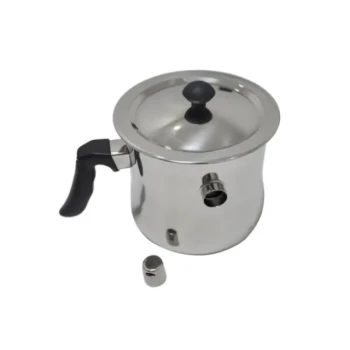The primary issue with high moisture content in honey is the significant risk of fermentation. When the water content rises above the safe threshold, naturally present osmophilic yeasts can activate and multiply, converting the honey’s sugars into alcohol and carbon dioxide. This process spoils the honey, degrading its flavor, aroma, and commercial value.
Honey’s remarkable shelf stability is not guaranteed; it is a direct result of its low moisture and high sugar concentration. Exceeding a moisture content of around 19% disrupts this delicate balance, creating an environment where dormant yeasts can thrive and initiate fermentation.

The Science of Spoilage: Why Moisture Matters
Honey is naturally hygroscopic, meaning it will absorb moisture from the air. Understanding the mechanics of how this moisture impacts stability is critical for anyone handling it.
The Role of Osmotic Pressure
Honey’s low water content creates extremely high osmotic pressure. This environment is hostile to microbes, as it effectively draws the water out of any yeast or bacteria cells, dehydrating and killing them.
This natural preservative effect is honey's primary defense against spoilage.
Activating Dormant Yeasts
Yeasts are naturally present in nectar and, therefore, in raw honey. They remain dormant and harmless as long as the moisture level is sufficiently low.
Once water content increases, the osmotic pressure drops. This "wakes up" the yeasts, providing them with the conditions needed to metabolize the sugars and begin the fermentation process, which is chemically similar to the making of mead.
The Critical Fermentation Threshold
The industry standard for premium, stable honey is a moisture content below 19%. Even a slight increase above this level dramatically raises the risk of fermentation, especially if the honey is stored in a warm environment.
From Premium Product to Problematic Stock
The consequences of high moisture are not just chemical; they have direct impacts on the honey's quality, usability, and value.
The Sensory Impact
Fermented honey is easy to spot. It will often have a sour or alcoholic "off" taste and a fermented, yeasty smell. You may also see bubbles or a layer of froth forming on the surface as carbon dioxide is released.
Loss of Commercial Grade
Honey with high moisture content cannot be sold as high-grade table honey. It is often downgraded to "baker's honey," a lower-value industrial product where the off-flavors can be masked by the cooking process.
This represents a significant financial loss for beekeepers and honey packers.
Practical Handling Issues
Beyond fermentation, excess moisture makes honey runnier and stickier. This can cause problems with packaging, leading to leaks and making the product difficult for consumers to handle and dispense without creating a mess.
Understanding the Common Causes
High moisture is rarely intentional. It is almost always a result of environmental conditions or procedural missteps during harvest and processing.
Harvesting Uncapped Honey
Bees cap honey cells with wax only after they have fanned their wings to dehydrate the nectar to the proper moisture level (typically around 18%). Harvesting frames with a high percentage of uncapped, "unripe" honey is a primary cause of high moisture content.
Environmental Factors
In regions with high humidity or during particularly wet seasons, it can be difficult for bees to reduce honey’s moisture to an ideal level. Furthermore, if honey is stored in an unsealed container, it can absorb moisture directly from the humid air.
Contamination During Extraction
Introducing water during the extraction and bottling process is another common pitfall. Using wet equipment, cleaning with water without thoroughly drying, or processing in a damp room can all increase the final moisture content of the honey.
Making the Right Choice for Your Goal
Controlling moisture is the single most important factor in preserving the quality and value of honey. Your approach should be tailored to your role in the honey's journey.
- If your primary focus is beekeeping for harvest: Prioritize harvesting fully capped frames and invest in a honey refractometer to test the moisture content of your crop before you extract.
- If your primary focus is processing and bottling: Ensure your extraction facility is climate-controlled and all equipment is completely dry before use. Test every batch for moisture before it is blended or bottled.
- If your primary focus is purchasing quality honey: Source from reputable producers and be wary of honey that appears unusually runny or shows any signs of fermentation, such as bubbling or a sour smell.
Ultimately, preserving honey's unique and timeless quality depends on meticulously managing its moisture from the hive to the jar.
Summary Table:
| Issue | Key Consequence | Critical Threshold |
|---|---|---|
| Fermentation | Spoilage, off-flavors, loss of commercial grade | Moisture > 19% |
| Quality Degradation | Sour taste, yeasty smell, bubbling | N/A |
| Handling Problems | Runnier consistency, packaging leaks | N/A |
Protect your honey's quality and profitability with the right equipment from HONESTBEE.
High moisture content is a direct threat to the value of your honey harvest or inventory. Don't let fermentation downgrade your premium product. HONESTBEE supplies commercial apiaries and beekeeping equipment distributors with the essential tools—like precision honey refractometers and climate-controlled processing equipment—to accurately measure and control moisture levels from harvest to bottling.
Ensure every batch meets the highest quality standards. Contact HONESTBEE today to discuss wholesale solutions for your operation.
Visual Guide

Related Products
- Precision Honey Refractometer Instrument for Quality Assessment
- Digital Honey Refractometer for Precision Measurement of Optimal Honey Quality
- Natural Wood Honey Dipper for Tea Coffee and Desserts
- Premium Heat-Resistant Glass Honey Dipper
- Easy Use Manual Stainless Steel Honey Press for Honey Comb
People Also Ask
- How does a honey refractometer work? Ensure Honey Quality & Harvest Readiness
- What are the key points for proper usage of a honey refractometer? Ensure Accurate Moisture Readings Every Time
- What is a honey refractometer and what is its purpose? Ensure Honey Quality and Prevent Spoilage
- Why is a honey refractometer important for beekeepers? Ensure Quality and Prevent Fermentation
- Why is a honey refractometer considered essential for commercial beekeepers? Ensure Honey Quality and Profitability



















